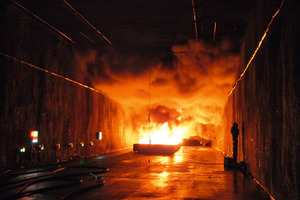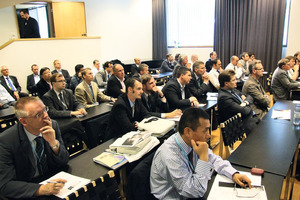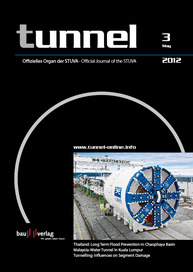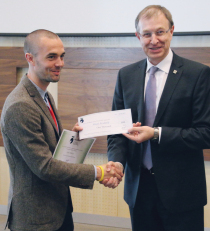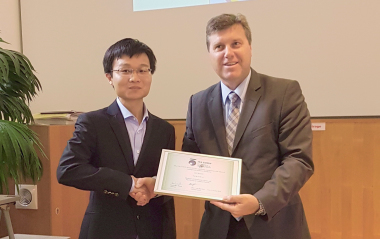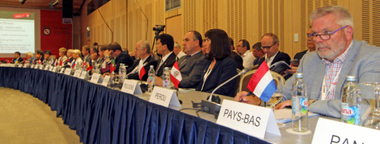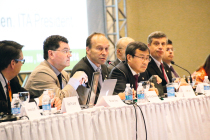ITA-COSUF: The Operation of Safe and Secure Underground Facilities
During the last decades, operational safety of underground structures has received increased public attention mainly after the disastrous fires in alpine road tunnels, fires in the Channel Tunnel as well as metro fires. The following article shows, what ITA-COSUF – the ITA Committee on Operational Safety of Underground Facilities - means.
1 Introduction
During the last decades, operational safety of underground structures has received increased public attention mainly after the disastrous fires in alpine road tunnels, fires in the Channel Tunnel as well as metro fires. Although operational safety always had been an important element in the design and construction of underground facilities it turned out to be a far more complex issue than anticipated before. The increase in traffic volume, especially regarding the transportation of heavy and dangerous goods, the age of certain infrastructures which need maintenance and/or considerable improvement in their safety installations after 20 years or even more in operation, the increasing complexity of underground infrastructures (complex underground road systems especially in urban areas with access and exit ramps, underground traffic circles and parking lots, longer and deeper tunnels for railway systems and deeper metro lines in combination with other urban infrastructures such as shopping malls, cinemas etc) – it all has severely increased the need for a holistic approach to the relevant safety issues.
It also became apparent that an holistic safety approach needs to start at the very early phases of the design and that it is afterwards a constant issue in all further design and construction phases. All corresponding operational aspects and the stakeholders involved occur and appear solely during the operational phase of the infrastructure, especially in case of an emergency. Regardless of the type of tunnel, the empowerment of its user to self rescue has to be considered as the dominating factor regarding the amount of possible risks, especially in terms of tunnel users and possible harm due to fire, smoke etc. Efficient concepts for safety-operation and corresponding technical measures are crucial.
Nowadays operating authorities need to consider securing societal assets, leading directly to assessments regarding the impact of a single incident on a traffic network as a whole and its robustness and resilience. These scenarios may be induced by changes in climatic conditions, accidents with dangerous goods or criminal actions and asymmetric threats. Dealing with the operation of underground facilities requires considering safety as well as security issues in a more and more holistic, comprehensive and decisive way.
2 Why COSUF?
The research projects and study groups funded by the European Union, following the aforementioned tunnel fires, enabled constituting a multidisciplinary network of experts working at universities, consulting firms, corporations and public service bodies throughout Europe. Many of these experts were motivated to establish a long-lasting cooperative framework in order to shape a comprehensive view of all tunnel safety and security aspects. Upon consultation with PIARC, the foundation of a committee associated with ITA-AITES (International Tunnelling and Underground Space Association) encompassing all types of underground facilities became a primary target. As a result, the Committee on Operational Safety of Underground Facilities (COSUF, Fig. 1) was created by ITA-AITES in May 2005. Since 2011, Didier Lacroix (France) is presiding over COSUF. Current members of COSUF are involved in some of the most integral national and international Research and Development projects within the EU regarding safety and security, such as METRO, SOLIT² or SKRIBTPlus.
COSF is open to any entity that develops an interest in the Committee‘s work and that would like to participate in its activities. In March 2012 the Committee membership stood at 72, a third of which are public bodies and training organizations and the remaining two-thirds stem from the private sector. Currently 22 countries from Asia, Australia and Europe are represented.
COSUF‘s objectives consist of: developing a forum for knowledge exchange; facilitating cooperative actions and international R&D initiatives; and promoting safety and security through innovation and acknowledgment of both current and future trends regarding all types of underground structures. The COSUF mission relies on the work of activity groups (AG), with the 4 most active ones described below.
3 Activities within COSUF
To facilitate the work on the special topics of interest regarding COSUF 4 so-called activity groups were formed, reflecting the specific approaches in terms of the underlying fields of expertise. All Members of COSUF can freely choose to take part in any of these groups, with AG 4 being the sole exception due to its narrowed field of application. In addition to typical group work the AG-members may be asked to help the steering board of COSUF in preparation of COSUF-related activities, such as internal or external workshops. These activities will be described in the following.
3.1 Activity Group 1: Interaction with European and International Initiatives
AG 1 is currently headed by Ben van den Horn (NL) and takes and keeps contact with other external institutions, groups and projects in order to receive relevant information, to co-operate for avoiding duplication of activities, to give information about activities in COSUF to external groups and possibly influence the initiatives.
The activities in Activity Group 1 consist e.g. of identifying and liaise with relevant initiatives outside COSUF, attracting COSUF members from these initiatives or appoint liaison responsible COSUF members, influencing initiatives to include safety and security aspects in line with the ideas of COSUF or bringing COSUF ideas to life as projects either as part of existing initiatives or as new separate projects.
3.2 Activity Group 2: Regulations and Best Practice
AG 2 is currently led by Peter Reinke (CH) and Stig Ravn (GB). It covers regulations, the state-of-the-art and best-practices in various countries. This includes discussion and comparison of regulations and best-practice procedures from different owners, networks, projects and the experience gained by them.
By doing this it is aimed to collect and distribute information on existing national and international regulations and recognized recommendations as well as to establish the best-practice recommendations for tunnel safety (and security). The findings can result in requirements for new regulations.
AG 2 addresses the following topics at the moment:
• Engineering guidance for scenarios and functional objectives for the design of fire safety of urban underground rail systems
• Engineering guidance and best-practice recommendations regarding man-machine-interface of SCADA systems for tunnels
• Best-practice recommendations for design of safety measures in road tunnels regarding implementation of EU directive on non-discrimination of disabled people
• Engineering guidance for fire protection of platform screen doors of underground rail
systems
The area of security may be highlighted as well, since there is a need for establishing the state-of-the-art also in this field and has not taken place to any extent up to now. Security deviates from safety particularly with
respect to the prevention, whereas the reaction consequence side may be similar to those which are resulting from evaluation and analysis of accidents or so.
3.3 Activity Group 3: Research and new findings
The scope of AG 3, which is currently led by Götz Vollmann (D), is to motivate research and to use research results and other new findings for the benefit of safety and security in underground facilities in general.
The activities include collection of results of research and new findings, the evaluation of events, results and new findings as well as the dissemination of the results and new findings among COSUF members. Additionally the group tries to collect and evaluate ideas for research and identify corresponding needs for the future and give directions for future research.
The actual launch of new research projects is initiated outside the COSUF frame but can certainly be facilitated through the activities of COSUF and the AG. Therefore AG 3 can also be considered as the starting point for national as well as international R&D-projects such as SOLIT². In a broader sense the group’s aim is to make aware all relevant professionals of new findings and recent results of research in safety and security related activities regarding underground facilities, to discuss these results and other ideas and to process them into specifications of needs of new research into recommended best practices. Additionally the partners try to facilitate recommendations on specific topics which then will represent the opinion of some of the world’s leading experts. For instance, the group is currently working on a recommendation regarding computational fluid dynamics (CFD) simulations as an elementary input for quantitative risk assessments of road tunnels (Fig. 2).
3.4 Activity Group 4: European Road Tunnel Safety Officers Forum
ITA-COSUF pays special attention to road tunnel safety within the framework of Directive 2004/54/EC of 29 April 2004 on minimum safety requirements for tunnels in the trans-European road network.
At November 4 to 5, 2009 in Lyon, ITA COSUF organized the 1st European Forum of Road Tunnel Safety Officers, an event which was co-organized by CETU, ITA-COSUF, PIARC and the European Commission. Forty-five Safety Officers from 18 member states participated to exchange information, evaluate first operational experiences and compare role and duty interpretation of the Safety Officers.
After this first event ITA-COSUF created the AG 4 within ITA-COSUF, the so-called Tunnel Safety Officers (TSO) activity group, being further led by Alain Picard (France). By doing so, the ITA-COSUF acknowledges that most of the functions and tasks assigned to the Safety Officers by the EU Tunnel Directive can only be achieved by a qualitative approach, making exchanges between Safety Officers of paramount importance and that this is entirely part of ITA-COSUF’s scope and objectives.
On the 18th of January 2012 again more than 40 tunnel safety officers from 18 European countries met in Brussels for taking part in the 2nd European forum to find out how to make road tunnels safer across the European Union. Participants expressed their wish to continue and to strengthen this fruitful cooperation with the support of the European Commission. Johan Bosch (NL), who supported Alain Picard in the preparation of this event, will soon take over as the new leader of this activity group and thereby strengthen the international exchange of experiences.
3.5 Additional workshops
On a frequent basis COSUF prepares and conducts internal and external workshops, at least one of each per year. While all external workshops are open for public contribution, internal workshops are seen as a special service for the COSUF members in general and the AG members in specific. That said, external workshops will be held at a certain location with presentations of different specialists regarding one topic, such as the external workshop on Risk Analysis Techniques and Approaches which was held in Frankfurt in 2011.
Internal workshops on the other hand are reserved only for COSUF-members. Therefore the steering board is looking to find excellent locations, where AG-meetings are easily combinable with site visits and additional presentations on the site itself and all site-related safety and security matters. That said, the steering board teamed up with more than 100 members of COSUF for our latest internal workshop in Amsterdam/Amersfoort (NL) where all participating members got to see the specific concepts regarding the Amsterdam North-South line. Thereby COSUF has served its members lots of valuable and interesting information in the course of more than 15 workshops throughout the last couple of years (Fig. 3).
4 Conclusion
As revealed in the accomplishments described above, COSUF‘s years of operations have yielded very encouraging results. Beginning with former members of European research projects, COSUF‘s composition has gradually grown, in terms of skill sets and geographic coverage, yet the added railroad and subway modes still need to be further developed.
COSUF has helped nurture synergy. Many methodological contributions specific to road tunnels stemming from PIARC and COSUF make it possible to overlap these contributions with problems raised by other types of underground facilities. Moreover, COSUF‘s research endeavours and the presence of industry representatives on the Committee provide access to research and innovation programs. The pursuit and expansion of COSUF activities, as the beneficiary of cooperation between PIARC and ITA-AITES, thus merits strong encouragements.


